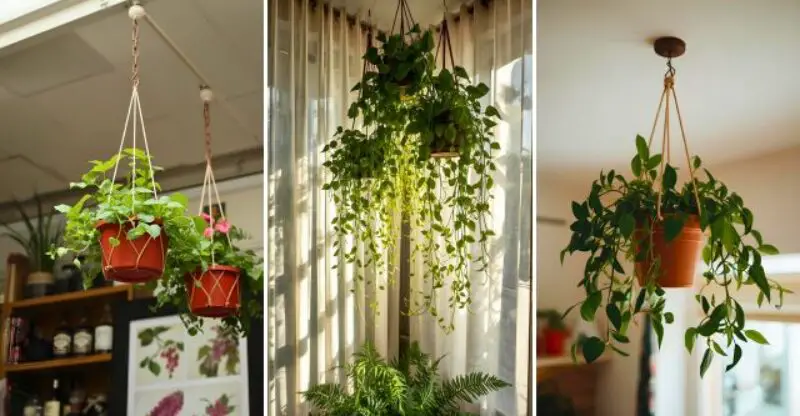How to Hang Plants from the Ceiling
Hanging plants from the ceiling is a wonderful way to bring nature indoors. It adds a touch of green to any room and makes your space feel more alive. Plus, it’s a great way to save floor space, especially in smaller homes or apartments. This guide will show you everything you need to know about hanging plants safely and beautifully.
We’ll cover the tools you’ll need, how to find the right spot on your ceiling, and step-by-step instructions for different hanging methods. Whether you’re a homeowner or a renter, we have a solution for you. Let’s get started and turn your home into a green oasis.
Hanging plants is also a key part of many 11 hanging houseplant ideas that can transform your living space. It’s a simple project that can make a big impact on your home’s decor.
1. Why Hang Plants from the Ceiling?
Hanging plants offers many benefits beyond just looking pretty. First, it’s a fantastic space-saver. If you don’t have much room for pots on the floor or shelves, looking up is the perfect solution. This is especially useful in apartments, dorm rooms, or any home where space is tight. It allows you to enjoy plants without cluttering your living areas.
Another great reason is that it can be better for your plants. Some plants need lots of sunlight, and hanging them near a window can help them get the light they need to thrive. It also keeps delicate plants away from pets or small children who might knock them over. This way, you can protect indoor plants while adding style to your home.
Finally, hanging plants can improve the air quality in your home. Plants are natural air purifiers, and having them around can make your home healthier. They can also boost your mood and create a calming atmosphere. For more ideas on how to decorate with greenery, consider some of the best plants for a courtyard garden which can also be adapted for indoor hanging.
2. Tools and Materials You’ll Need
Before you start, it’s a good idea to gather all your tools and materials. This will make the process much smoother and faster. You don’t need a lot of fancy equipment, but having the right tools is important for doing the job safely and correctly.
Here’s a list of what you’ll probably need:
- A drill and drill bits: This is for making a pilot hole in the ceiling.
- A stud finder: This little tool is a lifesaver for finding the wooden beams (joists) in your ceiling.
- A measuring tape: To find the right spot and make sure your plant hangs at the right height.
- A pencil: For marking the spot where you’ll drill.
- A hook: There are many types, like swag hooks or screw hooks. Make sure it can hold the weight of your plant.
- A ladder or step stool: To safely reach the ceiling.
For a great in-depth guide on choosing the right hardware, check out this article on hanging hardware for plants from Architectural Digest. Having the right tools makes any home project easier, whether you are hanging plants or installing the best floating shelves for your home.
3. How to Hang Plants from the Ceiling (The Drilling Method)
This is the most secure way to hang plants, especially heavy ones. It involves drilling into a ceiling joist, which is a wooden beam that supports the ceiling. It might sound a little scary, but it’s actually quite simple if you follow these steps.
First, you need to find a ceiling joist. Use your stud finder to scan the ceiling until it beeps. Mark the spot with your pencil. It’s very important to drill into a joist because drywall alone is not strong enough to hold a heavy plant. This is a crucial step for safety.
Next, use your drill to make a small pilot hole in the spot you marked. This makes it easier to screw in the hook. Then, screw your hook into the pilot hole until it’s tight and secure. Give it a little tug to make sure it’s firm. Once the hook is in place, you can hang your plant and adjust the height as needed. This method is perfect for creating a beautiful display, similar to the creative ways to display crystals and bring good vibes to your room.
4. Renter-Friendly Ways to Hang Plants Without Drilling
If you’re renting or just don’t want to make holes in your ceiling, don’t worry! There are plenty of ways to hang plants without drilling. These methods are easy to install and remove, and they won’t damage your ceiling.
One popular option is using adhesive hooks. These hooks are strong and can hold a surprising amount of weight. Just make sure to check the weight limit on the package before you buy. Another great choice is a tension rod. You can place it in a corner or between two walls and hang your plants from it. This is a great way to create a green curtain effect.
You can also use magnetic hooks if you have a metal ceiling or metal support beams. For more creative ideas, you can use a coat rack or a garment rack to hang your plants. These renter-friendly options can help you update your living room on a budget while still enjoying the beauty of hanging plants.
5. Choosing the Right Plants for Hanging
Not all plants are created equal when it comes to hanging. Some plants are naturally better suited for it because of how they grow. Vining plants, like pothos and philodendrons, are excellent choices because their leaves will trail down beautifully.
When choosing a plant, think about the amount of light in the spot where you want to hang it. Some plants need bright, indirect light, while others can tolerate low light. It’s also a good idea to choose plants that are relatively lightweight, especially if you’re using a no-drill hanging method. For the holidays, you could even hang some of the best holiday houseplants for a festive touch.
Some other great hanging plants include spider plants, string of pearls, and Boston ferns. For a comprehensive list of plant options, Good Housekeeping has a great article on the best hanging plants. Do a little research to find the perfect plant for your home and your lifestyle.
Conclusion
Hanging plants from the ceiling is an easy and rewarding project that can add so much life and color to your home. Whether you choose to drill a hook for a secure hold or use a renter-friendly option, there’s a solution that will work for you. By following the simple steps in this guide, you can safely and beautifully display your favorite green friends.
Remember to choose the right plants for your space and light conditions. With a little bit of planning and the right tools, you can create a stunning hanging garden that you’ll enjoy for years to come. So go ahead, get creative, and let your indoor garden reach new heights!



